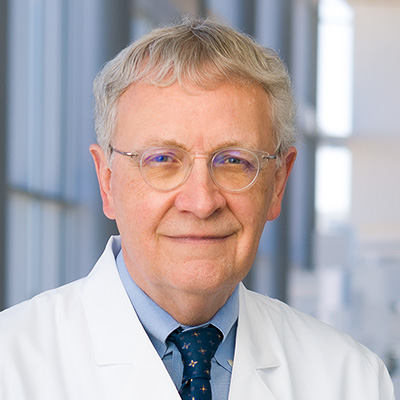- American Academy of Dermatology
- Society for Investigative Dermatology
- Dermatology Foundation
- American Society for Clinical Investigation
- American Dermatological Association
- American Association for the Advancement of Science

Kim Yancey, M.D.
- Dermatology - General
- Melanoma
- Skin Cancer
Biography
A native of Georgia, Kim B. Yancey, M.D., is Professor in the Department of Dermatology at UT Southwestern Medical Center. After graduating from the University of Georgia, summa cum laude and valedictorian, he earned his medical degree (Alpha Omega Alpha) from the Medical College of Georgia and performed his residency training there.
A National Institutes of Health-funded researcher for more than 25 years, Dr. Yancey completed a postdoctoral fellowship in immunodermatology in the Dermatology Branch of the National Cancer Institute at the National Institutes of Health (NIH). He is certified by the American Board of Dermatology, and also holds special competence in Dermatologic Immunology and Diagnostic Laboratory Immunology.
In 1985, Dr. Yancey joined the faculty of the Uniformed Services University of Health Sciences in Bethesda, Maryland as an Assistant Professor of Dermatology and was later promoted to Associate Professor, serving as Acting Chairman from 1990 to 1993. At the Uniformed Services University he was the only dermatologist on the full-time faculty, with responsibilities primarily related to investigative work. He also provided clinical services as a supervising physician at Walter Reed Army Medical Center, Bethesda Naval Hospital, and the National Institutes of Health.
Further pursuing his interest in biomedical investigation, Dr. Yancey re-joined the Dermatology Branch of the National Cancer Institute in 1993 as a Tenured Senior Investigator at the NIH. His NIH laboratory focused on mechanisms of keratinocyte adhesion to epidermal basement membrane and the pathophysiologic basis of autoimmune and inherited blistering diseases.
In 2001, Dr. Yancey was invited to join the faculty of the Medical College of Wisconsin (MCW) in Milwaukee as Professor and Chair of the Department of Dermatology. He divided his time among clinical, teaching, research, and administrative responsibilities at MCW, Froedtert Hospital, and the Zablocki Veterans Affairs Medical Center.
Dr. Yancey joined UT Southwestern in 2007 as Professor and Chair of the Department of Dermatology. His professional efforts focus on research, clinical care, education, administrative activities, and directing a team of over 25 dermatologists.
Dr. Yancey is a member of the American Society for Clinical Investigation, the Society for Investigative Dermatology, the Dermatology Foundation, the American Academy of Dermatology, the American Dermatological Association, and numerous other professional organizations. He is a former Director and Vice President of the American Board of Dermatology, a former President of the Society for Investigative Dermatology, a former Deputy Editor of the Journal of Investigative Dermatology, the current President of the Dermatology Foundation, a member of the Board of Directors of the Association of Professors of Dermatology, and a member of several editorial boards.
He was included in D Magazine's Best Doctors list for 2018, 2020, 2021, and 2022. In 2007, he received the American Academy of Dermatology’s Marion Sulzberger Award.
He has published numerous research manuscripts, monographs, and chapters, served on an array of grant review panels, and presented more than 150 scientific abstracts and invited lectures in the U.S. and abroad.
Meet Dr. Yancey
Dr. Kim Yancey’s path as a physician scientist began far away from Dallas, culminating here after years of advanced medical training, excellence in biomedical investigation and teaching, and the care of thousands of patients.
Before coming to Dallas, he was Chair of the dermatology department at the Medical College of Wisconsin, a smaller department and medical center, but with activities similar to UTSW.
“The opportunity here – not just in the Department of Dermatology, but in the greater institution itself – was quite unique, with its significant resources, robust community, and a trajectory toward growth and development in both clinical and basic sciences,” says Dr. Yancey, who was Chair of UT Southwestern's Department of Dermatology until 2023.
For Dr. Yancey, coming here was an opportunity to take a strong department to an even higher level.
“This department has been strong for several reasons, including its core academic strength as demonstrated by publications, grants, and scholarly activities; its solid cohort of clinicians who provide excellent care to patients; and its very creative residency training program with a track record of creating leaders in dermatology. We’ve been able to build on these traditional elements to further strengthen the department,” Dr. Yancey says.
Dr. Yancey believes that one of the novel aspects of UTSW’s dermatology department is having physicians with expertise in selected areas.
“They use that expertise in the clinic, then carry those observations and experiences back to their laboratory, where they pursue research that impacts patient care. Accordingly, the department is recognized as a resource to the greater community,” he says.
"I want our patients to know they will be seen by a caring, compassionate physician who will give them direct responses to their concerns, and who is embedded in a care network that will be able to support them."
Education & Training
- Medical School - Medical College of Georgia/Georgia Regents University (1974-1978)
- Fellowship - National Institutes of Health Clinical Center (1981-1985), Immunodermatology
- Residency - Medical College of Georgia (1979-1981), Dermatology
- Internship - Medical College of Georgia (1978-1979), Internal Medicine
- Other Post Graduate Training - National Institutes of Health (1981-1982)
Professional Associations & Affiliations
Honors & Awards
- D Magazine Best Doctor, 2018, 2020 – 2022
- President, Dermatology Foundation (2017 to date)
- Board of Directors, Association of Professors of Dermatology (2015 to date)
- President, Society for Investigative Dermatology (2011-2012)
- Board of Directors, Dermatology Foundation (2008 to date)
- Deputy Editor, Journal of Investigative Dermatology (2007-2010)
- Board of Directors, Society for Investigative Dermatology (2004-2009)
- Sulzberger Award and Lecture, American Academy of Dermatology (2007)
- Vice President, American Board of Dermatology (2005)
- Director, American Board of Dermatology (1997-2005)
Books & Publications
-
Publications
-
Hair follicle stem cells provide a functional niche for melanocyte stem cells.
Tanimura, S., Tadokoro, Y., Inomata, K., Binh, N.T., Nishie, W., Yamazaki, S., Nakauchi, H., Tanaka, Y., McMillan, J.R., Sawamura, D., Yancey, K., Shimizu, H., Nishimura, E.K. Cell Stem Cell 2011 8 177-187 -
Sequential intramolecular epitope spreading of humoral responses to human BPAG2 in a transgenic model.
Di Zenzo, G., Calabresi, V., Olasz, E.O., Zambruno, G., Yancey, K.B. J. Invest. Dermatol. 2010 130 1040-1047 -
Transient Anti-CD40L Co-Stimulation Blockade Prevents Immune Responses against Human Bullous Pemphigoid Antigen 2: Implications for Gene Therapy.
Lanschuetzer, C.M., Olasz, E.B., Lazarova, Z., Yancey, K.B. J. Invest. Dermatol. 2009 129 1203-1207 -
Humanization of autoantigen.
Nishie, W., Sawamura, D., Goto, M., Ito, K., Shibaki, A., McMillian, J.R., Sakai, K., Nakamura, H., Olasz, E., Yancey, K.B., Akiyama, M., Shimizu H. Nature Medicine 2007 13 378-383 -
Human bullous pemphigoid antigen 2 in transgenic skin elicits specific IgG in wild type mice.
Olasz, E., Roh, J.Y., Yee, C., Arita, K., Akiyama, M., Shimizu, H., Vogel, J.C., Yancey, K.B. J. Invest. Dermatol. 2007 127 2807-2817 -
The pathophysiology of autoimmune blistering diseases.
Yancey, K.B. J. Clin. Invest. 2005 115 825-828 -
Revertant mosaicism: partial correction of a germline mutation in COL17A1 by a frame restoring mutation.
Darling, T.N., Yee, C., Bauer, J.W., Hintner, H., Yancey, K.B. J. Clin. Invest. 1999 103 1371-1377 -
Autoreactive CD4+ T-cell responses to the extracellular domain of bullous pemphigoid antigen 2 (BPAG2) in patients with bullous pemphigoid.
Budinger, L., Borradori, L., Yee, C., Merk, H.F., Yancey, K.B., Hertl, M. J. Clin. Invest. 1998 102 2082-2089 -
Passive transfer of anti-laminin 5 antibodies induces subepidermal blisters in neonatal mice.
Lazarova, Z., Yee, C., Darling, T., Briggaman, R.A., Yancey, K.B. J. Clin. Invest. 1996 98 1509-1518 -
Epiligrin, the major human keratinocye intergrin ligand, is the target of disease in both an acquired autoimmune and an inherited subepidermal blistering skin disease.
Domloge-Hultsch, N., Gammon, W.R., Briggaman, R.A., Gil, S.G., Carter, W.G., Yancey, K.B. J. Clin. Invest. 1992 90 1628-1633
-
Hair follicle stem cells provide a functional niche for melanocyte stem cells.
Research
- Inherited blistering diseases (i.e., epidermolysis bullosa)
- Autoimmune blistering diseases
- Animal models of skin disease
Clinical Focus
- Melanoma
- Skin Cancer
Q&A by Dr. Yancey
Results: 1 Locations
Dermatology Clinic
at Professional Office Building 2 5939 Harry Hines Blvd., 4th Floor, Suite 100Dallas, Texas 75390 214-645-2400 Directions to Dermatology Clinic at Professional Office Building 2, Dallas Parking Info for Dermatology Clinic

